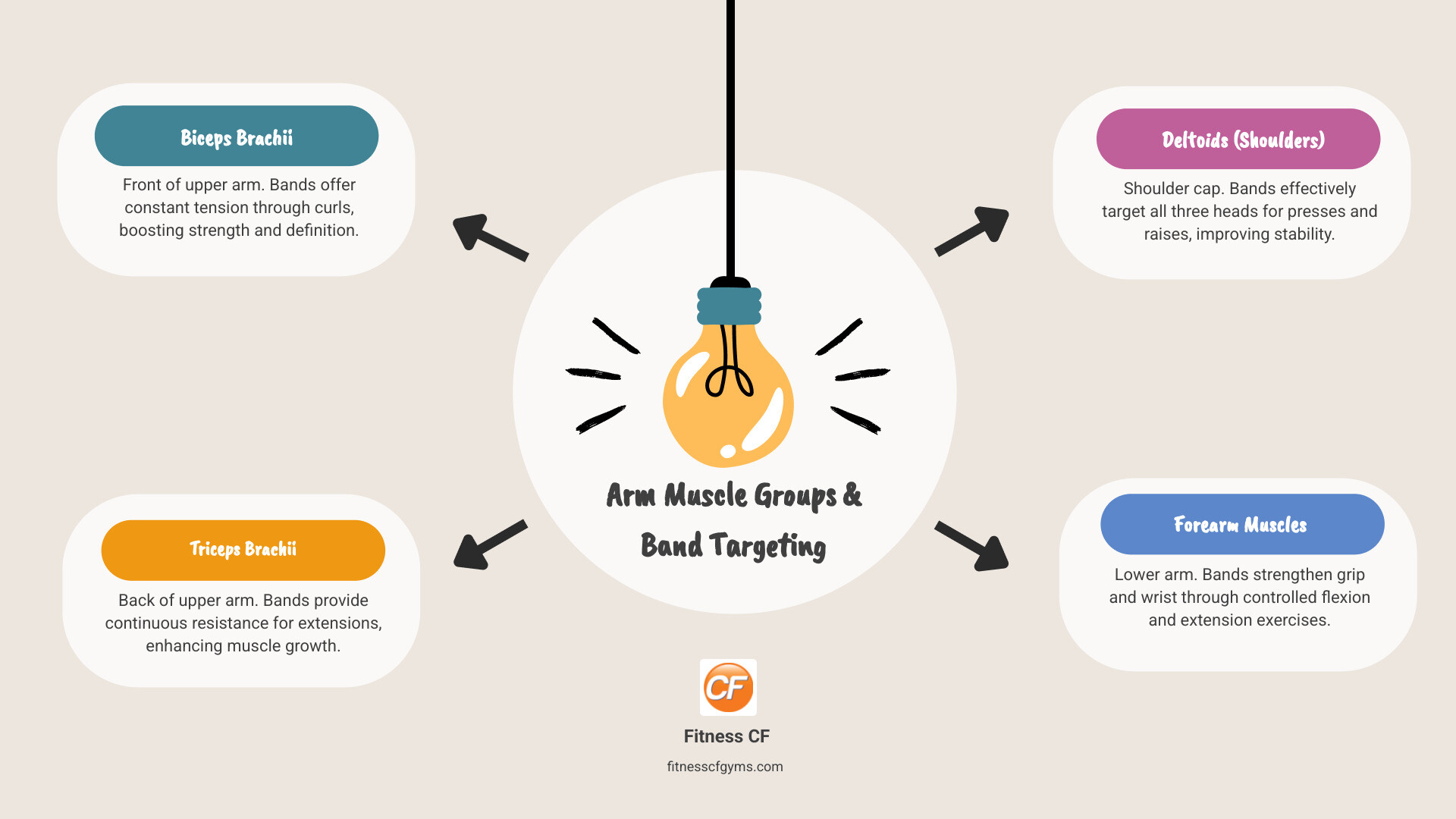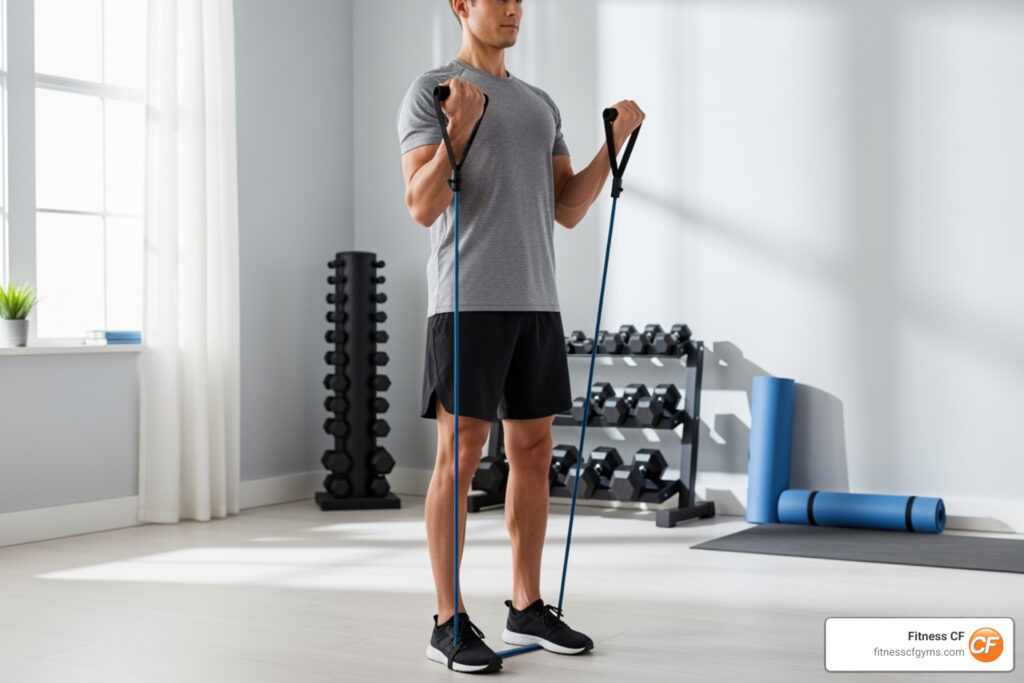Transform Your Arms with Resistance Band Training
Learning how to use exercise bands for arms can revolutionize your fitness routine without expensive equipment or gym memberships. Here’s everything you need to know:
Quick Start Guide:
- Choose your band – Start with light to medium resistance
- Anchor safely – Step on band or secure to stable object
- Focus on form – Keep movements slow and controlled
- Target all muscles – Work biceps, triceps, and shoulders
- Progress gradually – Increase resistance as you get stronger
Resistance bands create constant tension throughout your entire range of motion. This means your muscles work harder during both the lifting and lowering phases of each exercise.
Research shows that resistance band workouts were just as effective as weight training with traditional equipment. The bands offer unique benefits like improved flexibility, joint-friendly workouts, and the ability to target stabilizer muscles that dumbbells often miss.
Beyond the gym, developing strong, capable arms improves your quality of life. Everyday tasks—from carrying groceries and lifting children to simply opening a tight jar—become easier and safer. This functional strength fosters a sense of independence and confidence, which are cornerstones of a truly healthy and active lifestyle. It’s not just about looking good; it’s about feeling empowered in your daily movements.
Whether you’re a busy parent juggling family responsibilities or someone looking to break through fitness plateaus, resistance bands offer the flexibility to train anywhere, anytime. You can squeeze in effective arm workouts at home, in your office, or even while traveling.
As Pleasant Lewis, owner of Fitness CF with over 40 years in the fitness industry, I’ve seen countless clients transform their arm strength using resistance bands – learning how to use exercise bands for arms has become one of the most requested skills in my training programs. My experience has shown that consistent band training delivers real results when combined with proper form and progressive overload.

Why Choose Resistance Bands for Arm Strength?
If you’re looking to build stronger, more defined arms, resistance bands might be your best-kept secret. These simple tools offer some pretty amazing advantages that even surprise seasoned fitness enthusiasts.
The magic happens with constant tension. While dumbbells let gravity do some of the work (making certain parts of your movement easier), resistance bands keep your muscles working hard from start to finish. This creates what we call time under tension – and your muscles absolutely love this challenge.
Think about it this way: with bands, your biceps can’t take a break at the top of a curl, and your triceps stay engaged throughout an entire extension. This means more muscle fibers get recruited, leading to better strength gains and muscle development.
Your joints will thank you too. Resistance bands provide joint-friendly workouts that are naturally low-impact. Unlike heavy weights that can stress your joints, bands offer smooth resistance that flows with your natural movement patterns. This makes learning how to use exercise bands for arms perfect for anyone dealing with joint discomfort or those easing back into fitness after an injury.
Physical therapists have been using bands for injury recovery for decades. They help improve mobility and flexibility while rebuilding strength gradually. The bands let you work within your comfort zone while still challenging your muscles effectively.
Here’s something really cool: bands excel at muscle isolation while simultaneously engaging your stabilizer muscles. Those smaller, often-forgotten muscles that support your joints and larger muscle groups get activated with every rep. This creates better muscle balance and reduces your risk of future injuries.
The beauty of resistance band training lies in its functional nature. Every movement helps prepare your body for real-life activities. Think about the pushing, pulling, and lifting motions you do every day. Resistance band exercises mimic these patterns, building strength that translates directly outside of your workout time. Carrying groceries, lifting boxes, playing with your kids, or even opening stubborn jars becomes easier and less strenuous when your arms are conditioned with functional strength training. This practical application of strength is what helps prevent everyday strains and injuries, allowing you to live more actively and confidently.
You might wonder if bands can really compete with traditional weights. The research says absolutely! A 2019 study published in SAGE Open Medicine found that resistance band workouts are as effective as weights for building strength. Another study showed that upper-body moves with bands fire muscles like dumbbells, particularly for arm exercises.
Beyond building strength, bands naturally improve your flexibility and mobility as you work through full ranges of motion. This dual benefit of strengthening and stretching helps maintain healthy joints and prevents the stiffness that often comes with traditional weight training.
The combination of strength building, joint protection, and improved flexibility makes resistance bands an incredibly smart choice for arm training. To learn more about the foundational principles behind effective strength training, check out our guide on What is Strength Training and What Are Its Benefits?.
Getting Started: Choosing and Using Your Bands
Before we dive into specific exercises, let’s talk about the tools of the trade. Resistance bands come in a few different types, each with its own advantages for arm workouts. Understanding these differences is key to learning how to use exercise bands for arms effectively.
| Type of Band | Description | Best For | Resistance Levels |
|---|---|---|---|
| Tube Bands with Handles | Hollow rubber tubes with comfortable grips | Bicep curls, tricep extensions, shoulder presses | Light to extra heavy |
| Loop Bands | Continuous loops of rubber | Lateral raises, band pull-aparts, activation exercises | Light to heavy |
| Therapy Bands | Flat, wide strips of latex | Rehabilitation, gentle stretching, precise movements | Very light to medium |
Most bands use a simple color coding system to indicate resistance levels. While colors can vary between brands, you’ll typically find lighter colors (yellow, red) representing easier resistance, while darker colors (blue, black) indicate heavier resistance. Don’t worry about memorizing every color – what matters most is finding the right challenge for your current fitness level.
When selecting the right resistance for your arm workouts, start lighter than you think you need. Resistance bands feel different from traditional weights, and it’s better to master proper form with lighter resistance before progressing. The last two to three repetitions of each exercise should feel challenging but still allow you to maintain good technique.
Progressive overload – gradually increasing the difficulty of your workouts – is just as important with bands as it is with any other training method. You can progress by using heavier resistance bands, increasing your repetitions, or even combining multiple bands for extra challenge.
Before jumping into your arm exercises, never skip the importance of a proper warm-up. Spend five to ten minutes doing dynamic stretching – gentle arm circles, shoulder rolls, and light movement patterns that mimic the exercises you’re about to perform. This prepares your muscles and joints for the work ahead and helps prevent injury.
How to Use Exercise Bands for Arms Safely and Effectively
Mastering proper form should always be your top priority when learning how to use exercise bands for arms. Unlike weights that rely on gravity, bands create resistance in multiple directions, which means your stabilizer muscles need to work harder to maintain control.
Securely anchoring bands is crucial for both safety and effectiveness. When stepping on a band, make sure both feet are planted firmly with the band centered underneath. If using a door anchor or other attachment point, double-check that it’s stable before starting your exercise. The last thing you want is a band snapping back at you during a workout.
Speaking of avoiding snapping, always inspect your bands before each workout. Look for small nicks, tears, or worn spots that could lead to failure. Replace bands that show signs of wear – it’s a small investment compared to the potential injury from a snapped band.
Keep your core engaged throughout every exercise. This doesn’t mean holding your breath or creating tension in your neck and shoulders. Instead, think about gently drawing your belly button toward your spine while maintaining normal breathing. This engagement helps protect your lower back and improves the effectiveness of your arm exercises.
Focus on achieving a full range of motion with every repetition. Don’t rush through the movements or cut them short. The beauty of resistance bands lies in that constant tension we talked about earlier, but you only get that benefit when you move through the complete motion with control.
Most importantly, practice listening to your body. It’s crucial to learn the difference between the satisfying burn of muscle fatigue (often felt as delayed onset muscle soreness, or DOMS, a day or two later) and the sharp, sudden pain that signals a problem. While muscle soreness is a normal part of the strengthening process, joint pain or a stabbing sensation in the muscle is your body’s warning to stop. Pushing through this type of pain can lead to injury. Always stop and reassess your form or resistance level if you feel discomfort. Building strength is a gradual process that rewards consistency and smart training over reckless intensity.
For more detailed guidance on building impressive arm strength, check out our comprehensive guide on How to Build Arm Muscle. It’s packed with additional strategies that complement your resistance band training perfectly.







